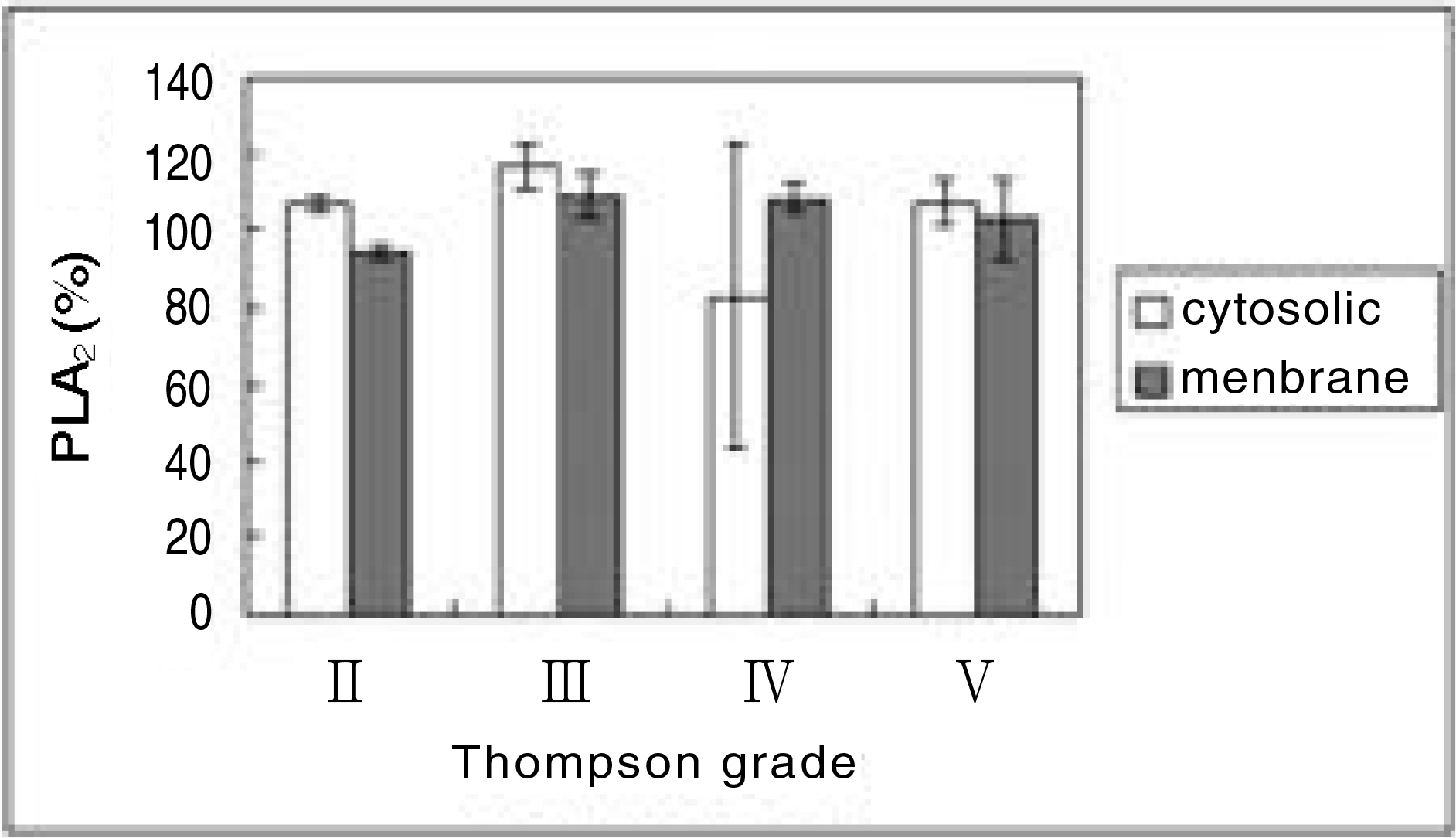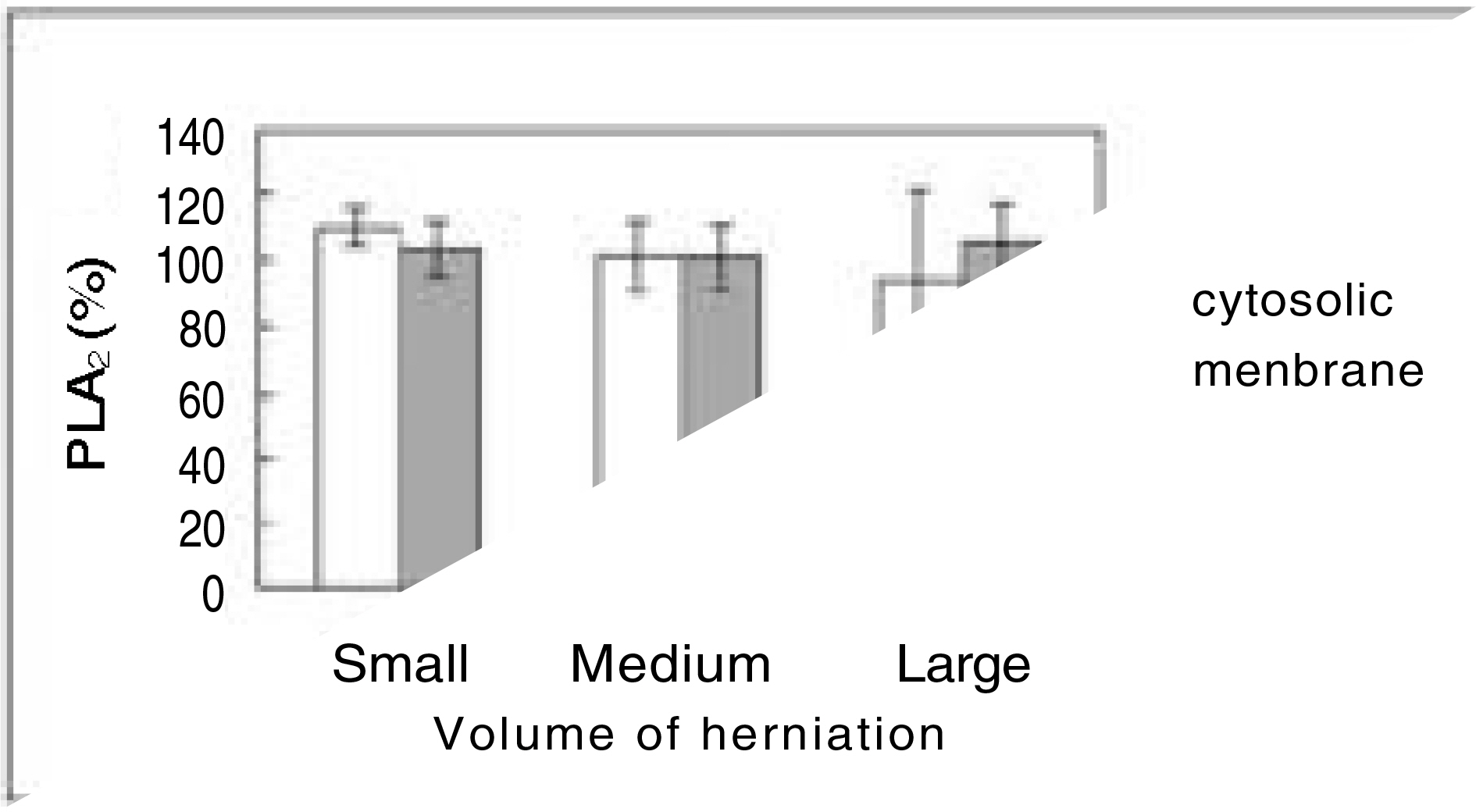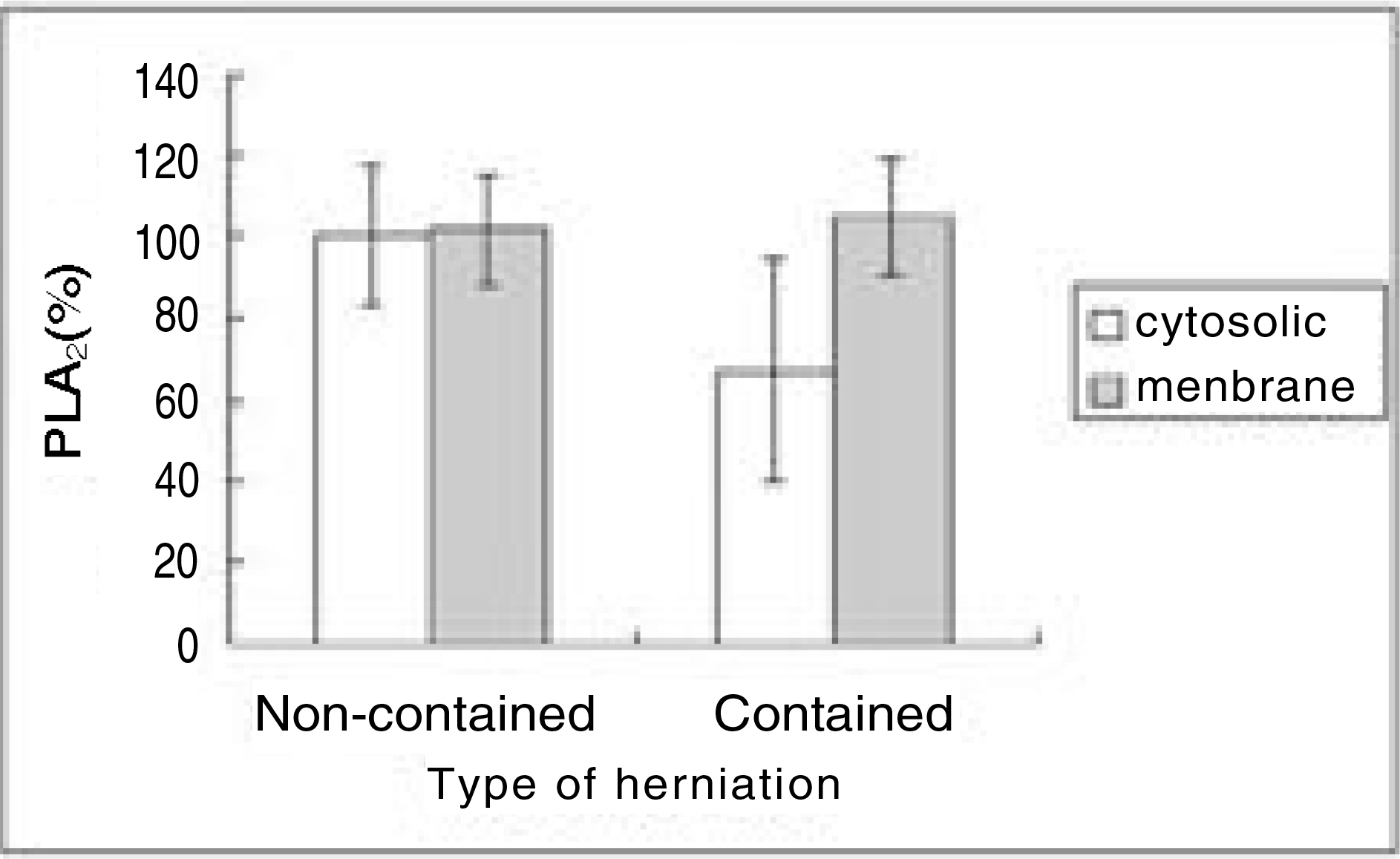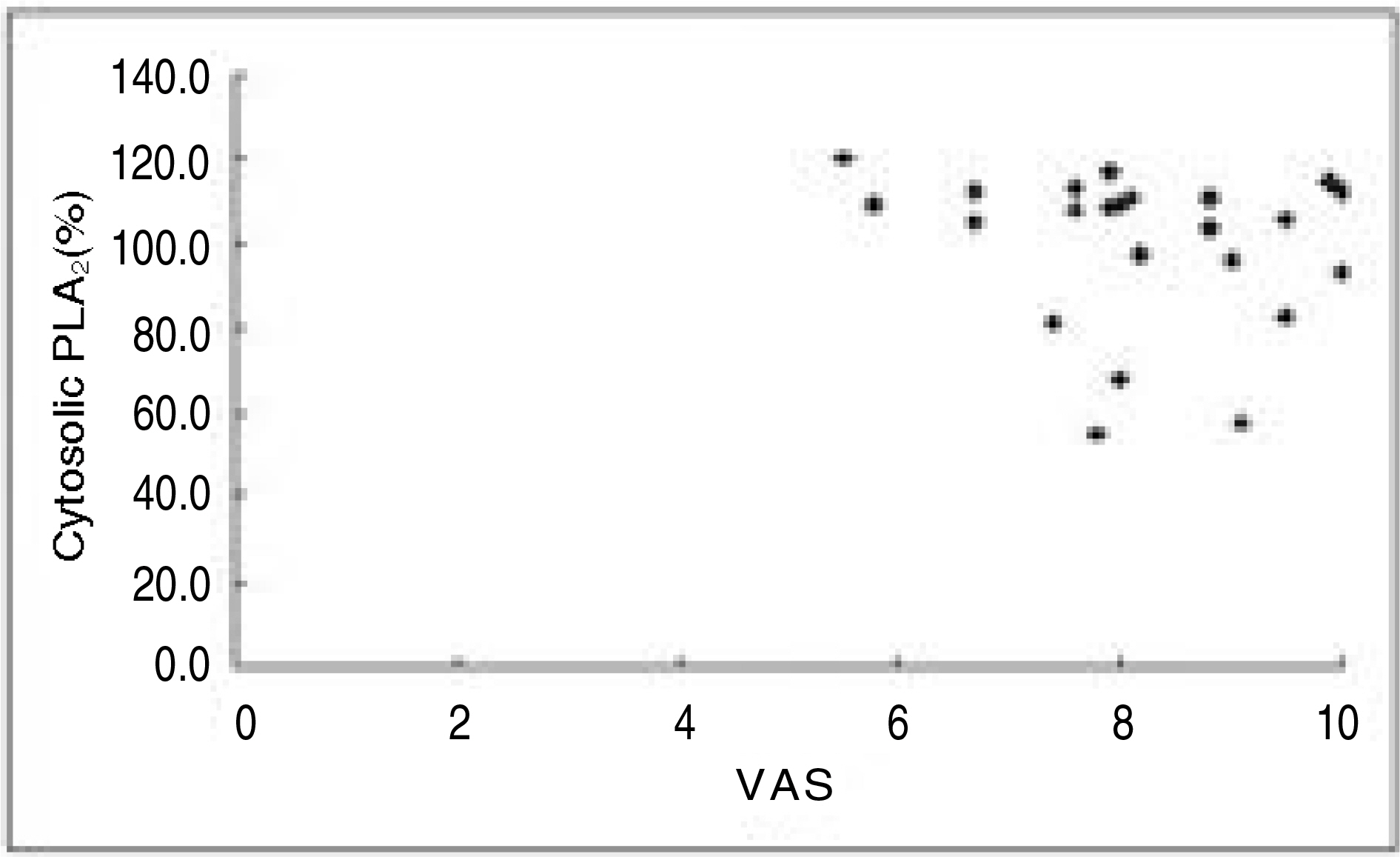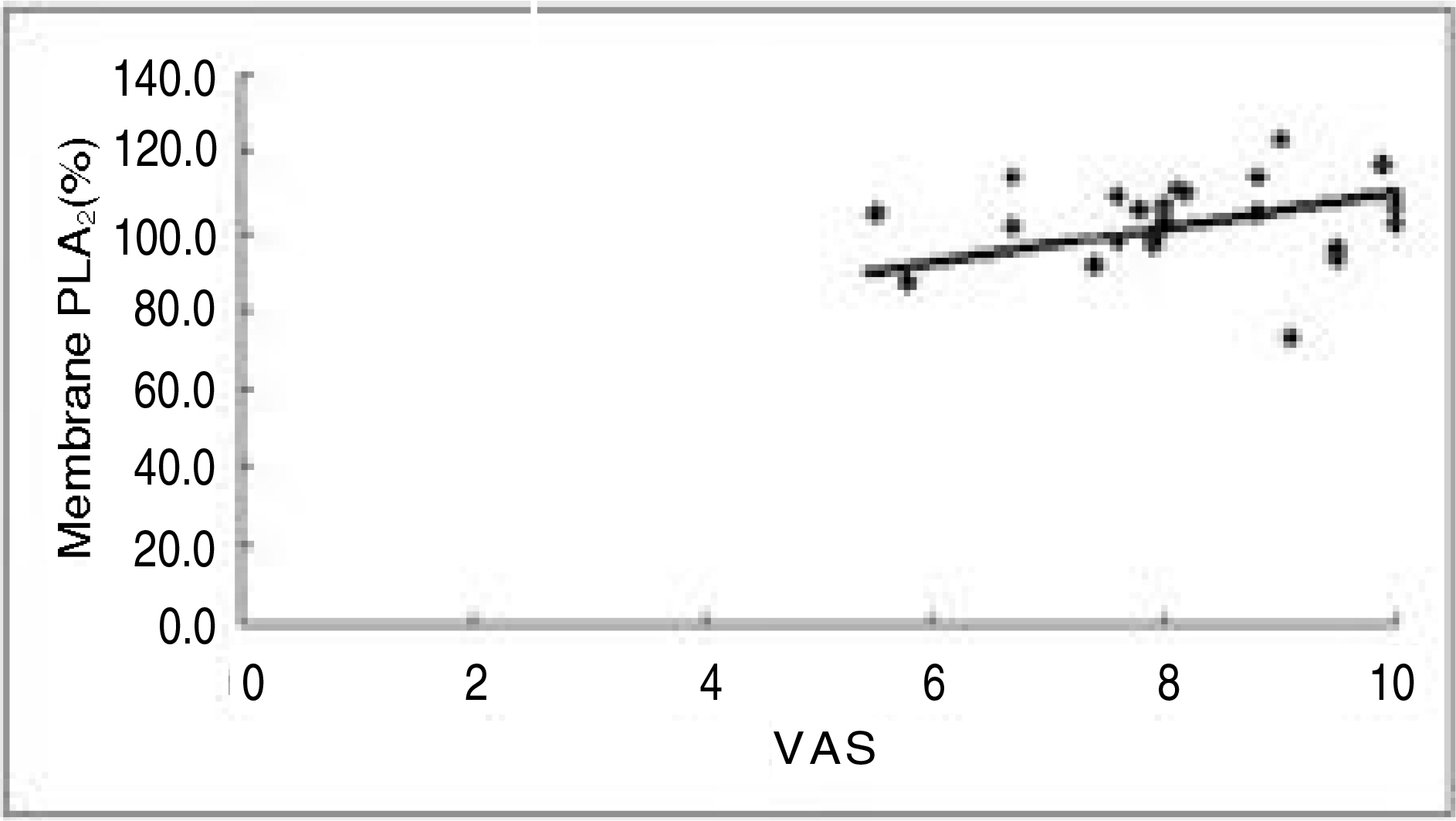J Korean Soc Spine Surg.
2002 Mar;9(1):8-13. 10.4184/jkss.2002.9.1.8.
Phospholipase A2 in Herniated Lumbar Discs: Its Relevance to Pain
- Affiliations
-
- 1Department of Orthopaedic Surgery, Yonsei University College of Medicine, Seoul, Korea. hwanlee@yumc.yonsei.ac.kr
- KMID: 1897084
- DOI: http://doi.org/10.4184/jkss.2002.9.1.8
Abstract
-
STUDY DESIGN: A prospective study.
OBJECTIVE
To determine whether phospholipase A2(PLA2) activity in herniated lumbar disc is correlated with clinical, radiographic and anatomic signs of the patients with herniated nucleus pulposus. SUMMARY OF LITERATURE REVIEW: Several studies have suggested inflammation around nerve root as a mechanism of sciatica and PLA2 emerges as a key enzyme of the inflammation. However, consensus about association between PLA2 and sciatica has been lacking. In addition, there has been no report that investigated the relationship between cytosolic and membrane PLA2 in herniated disc and patient's symptoms.
MATERIALS AND METHODS
Human intervertebral disc materials were obtained from 33 patients who underwent discectomy for HNP. The information was noted about smoking history, medication of NSAID, symptom duration, pain score on a visual analog scale(VAS), positive angle of straight leg raising test (SLR), neurologic deficits, Thompson grade of herniated disc, volume of herniation shown by the MRI and type of herniation based on the operative record. These data were matched to the PLA2 a ctivity in herniated disc measured using Western blotting analysis. PLA2 activity was expressed as the relative percentage compared to that of a 33-year-old female disc obtained during an operation for spinal fracture. The analysis was carried out using Mann-Whitney test, Pearson correlation analysis, simple linear regression analysis. A value of p<0.05 was considered significant.
RESULTS
Cytosolic and membrane PLA2 activity showed no statistical relationship to clinical, radiographic and anatomic characteristics of herniated disc. However, membrane PLA2(active form) activity was correlated with the pain score on VAS(p=0.013, r=0.481), while cytosolic PLA2(latent form) showed no statistically significant correlation with the pain score.
CONCLUSION
This study demonstrates that membrane PLA2 activity is correlated with the pain score. It also suggests that selective PLA2 inhibitors could be used for the alternative treatment modality of HNP.
MeSH Terms
-
Adult
Blotting, Western
Consensus
Cytosol
Diskectomy
Female
Humans
Inflammation
Intervertebral Disc
Intervertebral Disc Displacement
Leg
Linear Models
Magnetic Resonance Imaging
Membranes
Neurologic Manifestations
Phospholipases A2*
Phospholipases*
Prospective Studies
Sciatica
Smoke
Smoking
Spinal Fractures
Phospholipases
Phospholipases A2
Smoke
Figure
Reference
-
1). Balblanc JC, Conrozier T, Mathieu P, Tron AM, Bro-quet P, Piperno M, Richard M, Vignon E. Serum phospholipase A2 activity in osteoarthritis. Rev Rhum Ed Fr. 61:311–7. 1994.2). Burns PD, Graf GA, Hayes SH, Silvia WJ. Effect of oxytocin on expression of cytosolic phospholipase A2 mRNA and protein in ovine endometrial tissue in vivo. Domestic animal endocrinology. 19:237–46. 2000.3). Channon JY, Leslie CC. A calcium-dependent mechanism for associating a soluble arachidonoyl-hydrolyzing phospholipase A2 with membrane in the macrophage cell line RAW 264.7. J. Biol. Chem. 265:5409–13. 1990.4). Clark JD, Lin LL, Kriz RW, Ramesha CS, Sultzman LA, Lin AY, Milona N, Knopf JL. A novel arachi -donic acid-selective cytosolic PLA2 contains a Ca2 +-dependnet translocation domain with homology to PKC and GAP. Cell. 65:1043–51. 1991.5). Eyre D, Benya P, Buckwalter J, Frymoyer JW, Gordon SL. Intervertebral disc: Part B. Basic science perspective. New Perspectives in Low Back Pain. Park Ridge, IL: American Academy of Orthopaedic Surgeons;p. 147–207. 1989.6). Franson RC, Saal JS, Saal JA. Human disc phospholipase A2 is inflammatory. Spine. 17:S129–132. 1992.7). J⊘nsson B, Str⊘mqvist B. The clinical appearance of contained and non-contained lumbar disc herniation. lumbar disc herniation: a computeraided analysis of 2504 operations. J⊘nsson B, editor. ed.Lumbar Nerve Root Compression Syndromes. Sweden: Univeristy of Lund, Lund, Sweden;1995.8). Kortekangas P, Aro HT, Nevalainen TJ. Group II phospholipase A2 in synovial fluid and serum in acute arthritis. Scand J Rheumatol. 23:68–72. 1994.9). Kramer RM, Checani GC, Deykin A, Pritzker CR, Deykin D. Solubilization and properties of Ca2+-de pen -dent human platelet phospholipase A2. Biochem. Biophys. Acta. 878:394–403. 1986.10). Kramer RM, Roberts EF, Manetta J, Putnam JE. The Ca2 +-sensitive cytosolic phospholipase A2 is a 100-kDa protein in human monoblast U937 cells. J. Biol. Chem. 266:5268–72. 1991.11). Marshall LA, Bauer J, Sung ML, Chang JY. Evaluation of antirheumatic drugs for their effect in vitro on purified synovial fluid phospholipase A2. J Rheumatol. 18:59–65. 1991.12). Mats G, Johanna V, Seppo R, Ilkka K, Heikki V, Seppo S, Ralph FR, Richard DG. A controlled biochemical and immunohistochemical study of human syn -ovil-type(group II) phospholipase A2 and inflammatory cells in macroscopically normal, degenerated, and herniated human lumbar disc tissues. Spine. 21(22):2531–8. 1996.13). Muriel P, Pierre M, Pascal R, Pierre M, Anne MT, Gilles P, Marie JP, Michel R, Eric V. Phospholipase A2 activity in herniated lumbar discs: clinical correlations and inhibition by piroxicam. Spine. 22:2061–5. 1997.14). Nevalainen TJ, Märki F, Kortesuo PT, Grütter MG, Di Macro S, Schmitz A. Synovial type (group II) phospholipase A2 in cartilage. J Rheumatol. 20:325–30. 1993.15). Nygaard⊘ P, Mellgren SI, ⊘sterud B. The inflammatory properties of contained and noncontained lumbar disc herniation. Spine. 22:2484–8. 1997.
Article16). Saal JS, Franson RC, Dobrow R, Saal JA, White AH, Goldthwaite N. High levels of inflammatory phospholipase A 2 activity in lumbar disc herniations. Spine. 15(7):674–8. 1990.17). Sprangfort EV. The lumbar disc herniation: a computeraided analysis of 2504 operations. Acta Orthop Scand Suppl. 142:44–65. 1972.18). Vignon E, Mathieu P, Louisot P, Vilamitjana J, Harmand MF, Richard M. Phospholipase A2 activity in human osteoarthritic cartilage. J Rheumatol Suppl. 18:35–8. 1989.19). Yoshihara Y and Watanabe Y: Translocation of phospholipase A2 from cytosol to membranes in rat brain induced by calcium ions. Biochem. Biophys. Res. Comm. 170:484–90. 1990.
- Full Text Links
- Actions
-
Cited
- CITED
-
- Close
- Share
- Similar articles
-
- The Production of Phospholipase A2 in Different Types of Cultured Human Intervertebral Disc Cells
- Loss of Disc Height after Spontaneous Regression of a Herniated Lumbar Disc: A Case Report
- A Clinical Study of Chemonucleolysis for Herniated Lumbar Discs
- A Clinical Study of the Open Discectomy of the Herniated Lumbar Disc: Analysis of Relationship between Operative Indications and MRI Findings
- CT-Discography: Diagnostic Accuracy in Lumbar Disc Herniation and Significance of Induced Pain During Procedure

